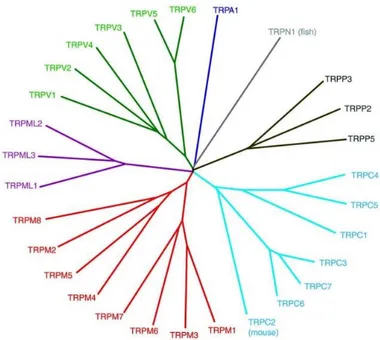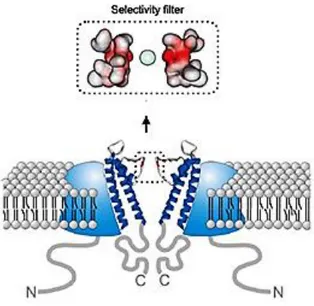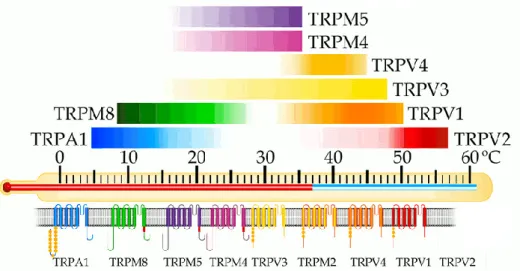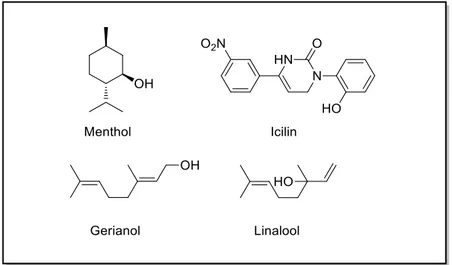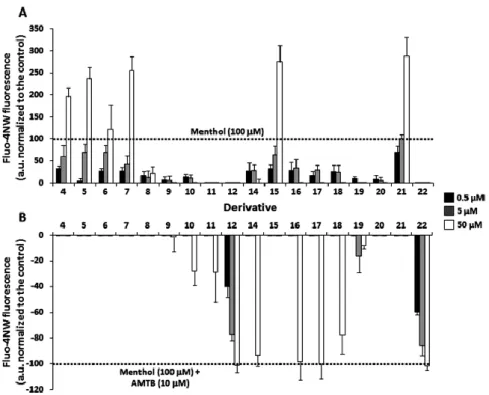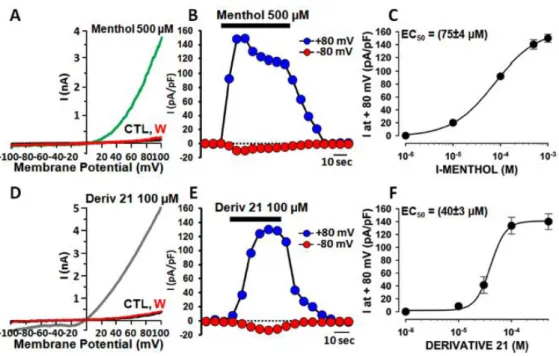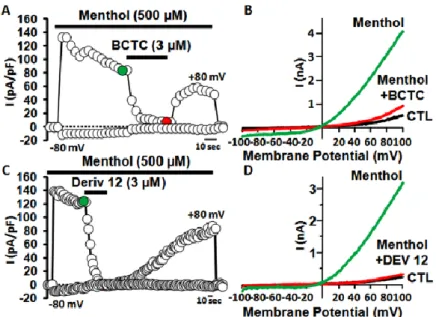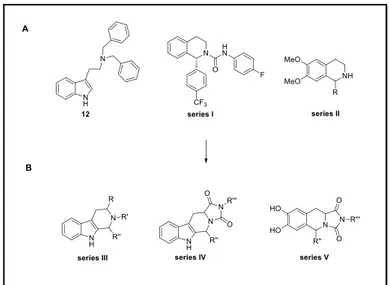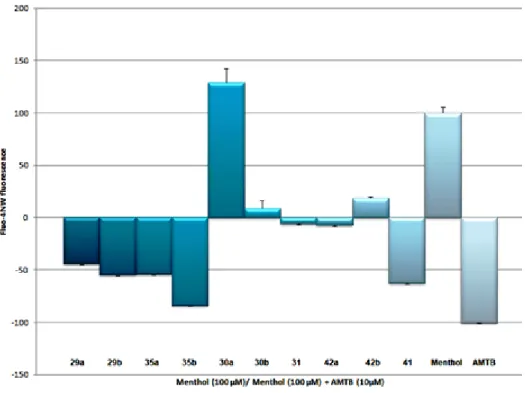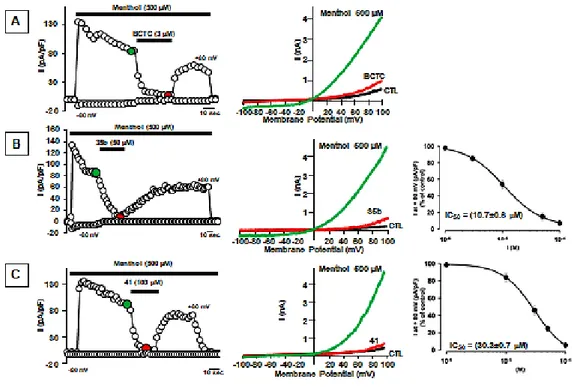UNIVERSITÀ DEGLI STUDI DI SALERNO
Dipartimento di Farmacia
PhD Program
in
Drug Discovery and Development
XXX Cycle — Academic Year 2017/2018
PhD Thesis in
Design and synthesis of bioactive small
molecules by traditional and innovative
methods
Candidate Supervisor
Tania Ciaglia Prof. Pietro Campiglia
INDEX
Abstract
CHAPTER 1: Design, synthesis and biological evaluation
of new TRPM8 modulators 1
1.1 Introduction: TRP, an overview 2
1.2 TRPM8: features, structure and localization 6
1.3 TRPM8: physiopathological role 8
1.3.1 TRPM8 and cancer 1.3.2 TRPM8 and pain 1.3.3 TRPM8 in overactive bladder and painful bladder syndrome 1.4 TRPM8 modulation 11
1.4.1 TRPM8 activators 1.4.2 TRPM8 inhibitors 2.1 Tryptamine-based derivatives as TRPM8 channel modulators: Background 15
2.2 Synthesis of 1st series 17
2.3 Activity and binding evaluation of the N-substituted Tryptamines synthesized 20
2.3.1 Screening of the activity of the 1st series by Ca2+-Imaging experiments on TRPM8 2.3.2 Screening of the activity of the 1st series by Ca2+-Imaging experiments on TRPA1 and TRPV1 2.3.3 Patch-Clamp Electrophysiology of the 1st series 2.3.4 Molecular modeling studies 3.1 Tetrahydro-β-carboline and tetrahydroisoquinoline-based TRPM8 modulators (series III, IV, V): Background and design 30
3.2 Synthesis of series III-V 31
3.3 Activity evaluation of series III-V 34 3.3.1 Screening of the activity of series III-V by Ca2+-Imaging experiments
on TRPM8
4.1 Tetrahydro-β-carboline and tetrahydroisoquinoline-based TRPM8 modulators (series III, IV, V, and VI): Background and
design of series III-VI 36
4.2 Synthesis of series III-VI 37
4.3 Activity evaluation of series III-VI 45
5.1 Conclusions 45
6.1 Chemistry 46
6.2 Pharmacology and molecular modeling 77
CHAPTER II: Ring fused cyclic aminals from THβC-based dipeptide compounds 83
1. Background 84
2. Chemistry and computational studies 86
3. Conclusions 93
4.1 Chemistry 94
4.2 Computational details 123
CHAPTER III: Indole-based derivatives as varicella zoster virus (VZV) inhibitors 127
1.1 Introduction 128
1.2 Pathogenesis of Varicella-Zoster Virus 128
1.3 Epidemiology of Varicella-Zoster Virus 129
1.4 Treatment and resistance 129
2.1 Background and design: 1st series 132
2.2 Synthesis of 1st series 133
3.1 Antiviral activity against Varicella zoster virus: 1st series 135
3.2 Antiviral activity against other members of the Herpesviridae family: 1st series 137
4.1 Background and design: 2nd and 3rd series 139
4.2 Synthesis 2nd and 3rd series 140
5. Antiviral activity against Varicella zoster virus: 2nd and 3rd series 141
6. Conclusions 142
7.2 Pharmacology 155
CHAPTER IV: Design and synthesis of potential GRK2 inhibitors 157
1.1 Introduction: GPCR main features 158
1.2 GRKs: main features 160
1.3 GRK2: physiopathological role 161
1.3.1 GRK2 and the cardiovascular system 1.3.2 GRK2 and the immune system 1.3.3 GRK2: role in cancer 1.3.4 GRK2 and the insuline resistance 2.1 Background and design: 1st series 166
2.2 Synthesis of 1st series 169
3. Activity of the thiazolidine derivatives of the 1st series 172
4.1 Background and design: 2nd series 173
4.2 Synthesis of 2nd series 174
5. Activity of the thiazolidine derivatives of the 2nd series 176
6. Conclusions 176
7.1 Chemistry 177
7.2 Pharmacology: GRK2 activity in rhodopsin phosphorylation assay 186
CHAPTER V: A continuos flow procedure for the difluoromethylation of aminoacids 189
1. Introduction 190
2. Aim of the study 193
3. Synthesis 196
4. Conclusions 201
5. Chemistry 202
Abstract
My PhD research plan concerns the exploration of the structural requirements determining TRPM8 modulation. We prepared a series of N-substituted tryptamines and identified two compounds acting, respectively, as an activator (21) or an inhibitor (12) of calcium influx in HEK293 cells. To develop more potent and selective derivatives we designed and synthetized new series of potential tetrahydroisoquinoline- and tetrahydro-β-carboline-based TRPM8 modulators. The synthetic approach used for the preparation of these compounds led to indole-fused aminoacetal derivatives. Optimization of reaction conditions allow us to obtain ring-fused aminals, which could be useful for preparing analogues of biologically active natural and synthetic products.
At the same time I worked on the synthesis of potential varicella zoster virus replication inhibitors: tryptamine derivative 17a was found to have a selective activity against this herpesvirus family member. A second part of my PhD was dedicated to the identification of small heterocyclic compounds as GRK2 inhibitors.
Lastly, I spent an abroad semester in the University of Graz, where I collaborated to the development of a continuous flow difluoromethylation protocol employing fluoroform as reagent. The protocol is applicable for the direct Cα-difluoromethylation of protected α-amino acids, and enables a highly atom efficient synthesis of the active pharmaceutical ingredient eflornithine.
1
CHAPTER I:
Design, synthesis and biological evaluation of new
TRPM8 modulators
2
1.1 Introduction: TRP, an overview
Transient receptor potential channels (TRP) play critical roles in the responses to all major classes of external stimuli, including light, sound, chemicals, temperature, and touch. TRP channels also imbue individual cells with the ability to sense changes in the local environment, such as alterations in osmolarity. Voltage and pH interact allosterically with temperature to activate the channel.1 TRP genes were first described in the fruit fly Drosophila melanogaster. In some of these flies, prolonged exposure to light induced transient photoreceptor depolarisation, whereas in the wild type the response was sustained. This difference was attributed to mutant TRP gene expression. Genetic ablation studies in worms, flies and mice indicate that TRPs serve as sensors to elicit responses to a variety of stimuli, ranging from temperature, osmotic pressure, olfaction, taste, mechanical stress, light and injury-induced inflammation mediating pain.2 Currently, more than 100 TRP genes have been identified in various animals (Table 1). Human TRP genes are diverse in length and range between 11.4 and about 911 kb. The overall protein sequence homology between subfamily members in the same species is usually about 35%.3
Table 1. TRP channel familya.
Drosophila melanogaster Caenorhabditis elegans Ciona intestinalis Fugu rubripes Danio rerio Mus musculus Homo sapiens TRPC 3 3 8 8 8 7 6 TRPV 3 5 2 4 4 6 6 TRPM 1 4 2 6 6 8 8 TRPA 4 2 4 1 2 1 1 TRPN 1 1 1 - 1 - - TRPML 4 1 9 2 2 3 3 TRPP 1 1 1 4 4 3 3 Total 17 17 27 25 27 28 27 a
TRP channel in the fruit fly Drosophila melanogaster, the worm Caenorhabditis elegans, the sea squirt
Ciona intestinalis, the puffer fish Fugu rubripes, the zebrafish Danio rerio, mouse and human. The numbers
3
Based on protein homology, members of the TRP channel family can be seen to fall into seven subfamilies: TRPC, TRPV, TRPM, TRPA, TRPP, TRPML e TRPN. The number of channels within each subfamily varies across species
(Figure 1), whilethe transmembrane segments tend to share the greatest homology within a particular subfamily.4
Figure 1. TRP subfamilies. (Adapted from Nilius et al., 2011).
The TRPV, TRPM, TRPA, and TRPN subfamilies are so called based on the original name of the initially described member of each subfamily. TRPVs (‘vanilloid’) are named after a founding member vanilloid receptor 1 (now TRPV1). The TRPM subfamily groups, with eight members (TRPM1–8), named after the original member, melastatin (now TRPM1). All members of the TRPA subfamily are nociceptive channels characterized by the presence of about 14 ankyrin repeats. The TRPN subfamily is named after the ‘NO-mechano-potential C’ (NOMP-C) channel of Caenor-habditis elegans. The TRPC subfamily (‘canonical’) comprises closest homologs of Drosophila TRP channels.TRPMLs and TRPPs include mucolipins and polycystins, respectively. The structure of the
4
integral channel endows the receptor with its characteristic nonselective cationic behavior and also potentially defines the outwardly rectifyingcurrent-voltage profile noted for many of these channels.5
All members of TRP family share a similar molecular architecture, most likely consisting of a symmetrical arrangement of four subunits, each of six transmembrane-spanning domains(TM1–TM6) and cytosolic N- and C-terminal tails that tetramerize to form a functional channel. TM5, TM6 and the connecting pore loop form the central cation-conducting pore, whereas TM1–TM4 and the cytoplasmic N- and C-terminal parts are thought to contain the regulatory domains that control channel gating.6
Compared with the six TM channels, TRP channels can have extremely long cytoplasmic N- and C-terminal tails containing several regulatory modules and, as in TRPM2, TRPM6 and TRPM7, can even contain entire functional enzymes. The relevance of these different cytoplasmic domains to channel functioning is poorly understood.7
Figure 2. TRP channel.
The heat-activated TRPV1 was first among a group of eight temperature-activated TRP ion channels called thermoTRPs (Figure 3). TRPV1 could be activated by elevated temperatures with a discrete threshold near 43°C.8 Three other TRPV channels TRPV2 (also known as VRL-1), TRPV3, and TRPV4 (also known as
5
VROAC or OTRPC4) have been cloned and characterized as heat or warm thermosensors.7-9 In addition, two TRPM channels (TRPM4 and TRPM5) have been recently reported to be thermosensitive.10 The threshold temperatures for the activation of these channels range from relatively warm (TRPV3, TRPV4, TRPM4, and TRPM5) to extremely hot (TRPV2). In contrast to these warmth- or heat-activated TRP channels, two other TRP channels TRPM8 and TRPA1 are activated by cold stimuli. All eight, when expressed in native cells (human embryonic kidney cells, chinese hamster ovary cells, Xenopus oocytes) have the property of rendering the cells temperature sensitive. Each one has unique characteristics, highlighted by distinct temperature thresholds of activation. Sensitization or desensitization to repeated thermal stimuli and the ability to be modulated by distinct signaling mechanisms further distinguish thermoTRPs.11
6
1.2 TRPM8: features, structure and localization
Transient receptor potential melastatin type 8 (TRPM8) is a non-selective Ca2+ permeable channel, that behaves as a polymodal receptor and exhibits highly complicated gating behavior that is regulated by a variety of factors.3 It has been demonstrated that cool temperature opens TRPM8 channels localized on the membranes of somatic sensory nerves, causing sensory nerve excitation. TRPM8 was the first cold-activated ion channel to be identified and it established the general role for TRP ion channels in thermosensation. When expressed on heterologous cell systems, cooling temperatures below 24–28°C start to evoke depolarizing currents. TRPM8-mediated currents increase with decreasing temperatures and reach maximum currents near 10°C.5
Electrophysiological studies have indicated that TRPM8 activation results in a large increase of intracellular Ca2+ levels through both Ca2+ entry from extracellular sites and Ca2+ release from intracellular Ca2+ stores. TRPM8 is activated by endogenous agonists or mechanisms other than temperature, such as depolarizing voltages.12,13
The human TRPM8 polypeptide consists of 1104 amino acids.14 The channel is formed by four identical subunits. Each subunit shows 6 transmembrane domains (S1-S6) that surround the central pore, with S5 and S6 forming the gate and selective filter, while the S1–S4 transmembrane domains exhibit weak voltage-sensing properties. The N- and C-terminal domains are in the cytoplasmic side.15 The C-terminal domain, which confers temperature sensitivity on TRPM8, appears involved in tetramer stabilization since some mutations within the coiled region of C-terminus (978–1104) markedly reduce the ability of the TRPM8 monomers to form oligomeric channels. Single-point mutation in this region, Leu-1089 into Pro, disrupts this interaction and reduces oligomerization and surface expression of TRPM8, without affecting total protein. The "TRP box", in common with all the TRP family members, and a binding site for phosphatidylinositol 4,5-bisphosphate, are located in this C-terminal tail. Functional TRPM8 channels require the presence of the C-terminal as well as the region compromised between amino acids 40 to 86 of the N-terminal which are essential for the localization to the plasma membrane.16 On the other hand, N-terminus should not play a
7
significant role in tetramerization since the analysis of deletion mutants shows that the transmembrane domain is sufficient for TRPM8 assembly into tetramers (Figure 4).17
The protein shows 8 putative glycosylation sites and an immunogenic epitope that will facilitate the future design of peptide vaccination.16
The first four helices (S1–S4) constitute the voltage sensor module and include the binding sites for activators as menthol and icilin, although they do not fully overlap, since most residues involved in menthol recognition are located in S2, whereas icilin interacts also with residues of S3.18
The last two TM helices (S5–S6) constitute the pore module, which is characterized by a highly conserved hydrophobic region and a conserved aspartate residue, whose neutralization results in a non-functional channel. Moreover, the S6 helix is responsible for the ion selectivity of TRPM8 since the introduction of positively charged residues switches from cation to anion selectivity.19
Figure 4. Schematic representation of TRPM8 protein. (Adapted from Latorre et al., 2011).
8
TRPM8 is expressed mainly in a subpopulation of primary afferent neurons from both, dorsal root and trigeminal ganglia, and in the nodose and geniculate ganglia in the peripheral nervous system. The protein has been also identified in prostate and genitourinary tract, bladder, sperm, vascular smooth muscle, liver, lung and odontoblasts. Moreover the channel is expressed in the plasma membrane, in the membrane rafts and in the endoplasmic reticulum membrane of prostate cancer cells.20
1.3 TRPM8: physiopathological role
1.3.1 TRPM8 and cancer
The role of TRP channels in cancer is highly heterogeneous, ranging from the control of Ca2+ homeostasis to regulation of tumourigenic and metastatic events. Tumour progression can be generally associated with misregulation of either one or more TRP channels.
TRPM8 is overexpressed in many prostate, breast, colon, lung and skin cancers,21 and this behaviour makes it an attractive target for cancer modulation.22 Moreover, TRPM8 may be effectively used in prostate cancer diagnosis and staging.23,24
Several studies suggest that TRPM8 expression is regulated by androgens, thus the channel levels decrease when prostate cancer cells become androgen-independent. This has been confirmed in recent more direct experiments which reported androgen-dependent TRPM8 expression in the androgen-responsive LNCaP (androgen-sensitive human prostate adenocarcinoma cells) cell line, but not in the androgen-unresponsive PC-3 cell line.25
It has been recognized that the androgen receptor (AR)2 protein is an important transcription factor for TRPM8 expression in prostate cells.26 In general, androgens are important regulators of reproductive organs and are also involved in the pathogenesis of prostate cancer, including progression and metastasis.27 An intensive colocalization pattern of the TRPM8 protein with endogenous androgens in human prostate tissues obtained from healthy individuals and patients with prostate cancer at various stages of the disease, as well as in cultured cells, was
9
detected, suggesting possible interactions. Co-immunoprecipitation experiments performed using cultured prostate epithelial cells, prostate cancer cells, and HEK-293 cells stably expressing TRPM8 further confirmed direct binding of the steroid hormone, testosterone, to the TRPM8 protein, suggesting that testosterone-induced TRPM8 could be an important regulator of Ca2+ homeostasis in prostate cells. In this view, TRPM8 would be an important channel to control cell cycling, including growth, proliferation, and apoptosis and down-regulation of plasma membrane TRPM8 activity could have an impact on cancer development.28
1.3.2 TRPM8 and pain
The use of cooling to produce analgesia is described since Hippocrates and Galen.29 Preparations containing menthol, which produces a cool sensation, are used topically to relieve neuralgia in traditional chinese and european medicine.30 Several clinical trials show beneficial effects of cooling on chronic back pain, dental pain, postoperative pain, and muscle injuries but no definitive mechanism has been established for cool-induced analgesia.31 All these data greatly promote the progress in exploring the relationship between temperature and pain.
TRPM8 seems the best candidate for being the mediator of cooling-induced analgesia. Mouse knockout studies have revealed that TRPM8 is required for cold sensation over a broad range of innocuous and noxious cold temperatures.32 A central spinal mechanism of analgesia is suggested, because cutaneous cooling can prevent pain produced by afferent stimulation. In addition several studies demonstrated marked analgesic effects of peripherally or centrally applied TRPM8 activators (such as icilin or menthol), or mild cooling of the skin, in a model of neuropathic pain. The channel response to agonists depends on their concentration, as low doses of menthol induce a sensation of cooling and analgesia in inflammatory and neuropathic pain models. Much higher doses of menthol induce a noxious cold sensation, although it is not clear if TRPM8 is specifically being targeted at such doses.29b
An increased expression of these channels or an alteration in their functional properties could lead to the lower thresholds for cold pain and increased sensitivity to cold seen in neuropathic pain states.33 Moreover several studies have
10
shown that levels of TRPM8 protein and RNA were both increased in rats with chronic neuropathic pain. In addition, inflammatory factors such as H+,34 bradykinin and phospholipase can affect the activation of TRPM8. 35,36 Several studies also showed that TRPM8 plays a role in amplifying pain sensation after injury, especially in models of neuropathic pain.Whereas hypersensitivity to cold is a common feature of individuals with neuropathies, these data suggest that patients suffering from cold hyperalgesia may respond best to TRPM8 antagonists.37
1.3.3 TRPM8 in overactive bladder and painful bladder syndrome
TRPM8 is widely expressed in the urothelium and suburothelial sensory fiber and seems to be implicated in the bladder cooling reflex.38,39 The expression of TRPM8 is consistent with a role in the initiation of pain or the micturition reflex, with message being concentrated in the urothelium lining the bladder as well as in the dorsal root ganglia (DRG). Studies in a variety of animal models have shown that either cold or intravesical menthol induced micturition or increase bladder contraction frequency in a spontaneously contracting bladder.40
Recent studies showed that the density of TRPM8 channels is elevated in bladder afferent nerve fibers of overactive bladder syndrome (OAB) patients, with an even higher density in patients with bladder pain. The positive correlation between the density of TRPM8 in the bladder mucosa and increased TRPM8 expression in patients with bladder pain, led to the suggestion that this channel was involved in the symptomatology and pathophysiology of these disorders.41 These observations suggest that a blocker of the TRPM8 channel could be effective for treatment of OAB and bladder pain.
11
1.4 TRPM8 modulation
1.4.1 TRPM8 activators
The activity of TRPM8 was shown to depend on a variety of stimuli.
Phosphatidylinositol 4,5-bisphosphate [PI(4,5)P2] in cellular systems activates this channel through interactions with positively charged residues in the cytoplasmic tails.42 In addition, several studies has examined the role of phospholipase A2 (PLA2) in the activation of TRPM8. All PLA2 enzymes hydrolyze the sn-2 ester of glycerophospholipids to release a free polyunsaturated fatty acid (PUFA) and a lysophospholipid (LPL). Two main groups of intracellular PLA2 enzymes exist, cytosolic PLA2 (cPLA2) and calcium-insensitive PLA2 (iPLA2), also called group IV and group VI PLA2, respectively. Although cPLA2 is selective for phospholipids with arachidonic acid in the sn-2 position, this is not the case for iPLA2, which releases other fatty acids as well. Recently has been reported that lysophospholipids, produced by PLA2 activity, positively modulate TRPM8 and can act as endogenous agonists to activate the channel at normal physiological temperatures. In contrast, PUFAs such as arachidonic, eicosapentaenoic, and docosahexaenoic acid inhibit TRPM8. Although the two groups of PLA2 products exert opposing modulatory effects on TRPM8, the net balance of equimolar concentrations of the PLA2 products favors TRPM8 activation. These data introduce lysophospholipids as novel modulators of thermosensitive TRP channel activity.43
TRPM8 can also be activated by menthol, the active ingredient of pepper mint, and by other cooling compounds as eucalyptol (the active ingredient in eucalyptus oil), the super-cooling AG-3-5 (also known as icilin), geraniol, hydroxycitronellal, linalool, PMD38, WS-3, and WS-23.44 Of these AG-3-5 bears little structurally resemblance to menthol and is more potent and effective than menthol in activating TRPM8.45 Interestingly, the mechanism whereby AG-3-5 activates TRPM8 is different than that of menthol or cold. AG-3-5 requires a coincident rise in cytoplasmic calcium, either via permeation through the channel or by release from intracellular stores, in order to evoke TRPM8 currents, suggesting that the channel can be activated by multiple mechanisms.
12
In addition mutational studies identified a critical amino acid (Gly805): when mutated, it makes AG-3-5 unable of activating TRPM8.46 This residue was located between the second and third transmembrane domains of the channel, a region known to be important for capsaicin sensitivity of TRPV1.47
Figure 5. TRPM8 chemical activators.
1.4.2 TRPM8 inhibitors
Despite different positive modulators of TRPM8, a large class of inhibitors are subject to intense studies.
Endogenous antagonists comprise bradykinin, a proinflammatory agent, significantly downregulate TRPM8 in a PKC-dependent manner.48,49 Moreover several synthetic and natural antagonists have been identified, including BCTC (4-(3-Chloro-2-pyridinyl)-N-[4-(1,1-dimethylethyl)phenyl]-1
piperazinecarboxamide), thio-BCTC, CTPC ((2R)-4-C3-chloro-2-pyridinyl)-2-methyl-N-[4-(trifluoromethyl)phenyl]-1-piperazinecarboxamide), and capsazepine.50 The antifungal medication clotrimazole has strong TRPM8 antagonistic activity, but also activates TRPV1 and TRPA1, actions consistent with the commonly reported side effects of irritation and burning.51 SKF96365, a non-specific blocker of several types of calcium channels, receptor-operated channels and inwardly rectifying potassium channels, also inhibits TRPM8 in vitro.52Certain tryptamine derivatives that are ligands for 5-benzyloxytryptamine
13
receptors also act as TRPM8 antagonists.53 Lastly, ethanol, at concentrations of 1– 3%, inhibits TRPM8 channel function by disrupting interactions with the membrane phospholipid phosphatidylinositol 4,5-bisphosphate (PIP2), an obligate molecule for TRPM8 channel function.54
Several structural classes of nanomolar TRPM8 antagonists have been reported, including substituted 4-phenylmethylamides (M8-B) benzyloxy-benzoic acid amides (AMTB), (1-phenylethyl-4-(benzyloxy)-3-methoxybenzyl(2-aminoethyl)carbamate (PBMC) and benzyloxy-phenylmethylureas.50 Some of these compounds are patented for the treatment of urological disorders, although there are no data available on the in vivo efficacy of any of these compounds in animal models of these diseases. High affinity antagonists M8-B, AMTB and PBMC have been used as selective pharmacological probes of TRPM8 to explore the range of therapeutic applications resulting from blockade of this receptor, such as the regulation of deep body temperature, treatment of urological disorders and cold hypersensitivity associated with inflammatory and neuropathic conditions.55 In vitro, PBMC is the most potent TRPM8 antagonist reported to date and inhibits channel activation to both chemical and thermal stimuli. Using calcium microfluorimetry and whole cell electrophysiology, PBMC was found to reduce TRPM8 activity in a dose-dependent manner and unlike other TRPM8 antagonists, any cross reactivity was observed with either TRPV1 or TRPA1. 56
14 Figure 6. TRPM8 chemical inhibitors.
Indeed, many of these compounds also antagonize the heat-gated channel TRPV1. Thus, there is significant pharmacologically overlap between the two channels,57 which suggests a conserved mechanism for ligand activation of the thermosensitive TRP proteins. These results complicate the search for selective agents for TRPM8 channels.44
15
2.1 Tryptamine-based derivatives as TRPM8 channel modulators: Background
Because of its above described role as cellular sensor, TRPM8 represents a good target for therapeutic intervention. Actually, most of current TRPM8 inhibitors showed also agonistic/antagonistic properties towards other receptors and have side effects that justify the need for new, more selective compounds.
The design and synthesis of new TRPM8 modulators is a central goal of my PhD programme because of their potential therapeutic applications in cancer and pain process.
Recently, some indole compounds have been identified as potent and selective TRPM8 antagonists. Voacangine (1), an iboga-type indole alkaloid, is found in the root bark of Voacanga africana Stapf ex Scott-Elliot (Apocynaceae) and it is characterized by the presence of an isoquinuclidine ring. This compound acts as modulators for TRPV1, TRPM8, and TRPA1. Voacangine showed TRPA1 agonistic and notable TRPM8 antagonistic activity.58
Also 5-substituted tryptamines have been studied as potent TRPM8 blockers and a structure-activity study described some important determinants of TRPM8 activity. In detail, the phenyl ring and ethylamine side-chain were found to be important to the antagonist activity of 5-benzyloxytryptamine (Figure 7).53
Figure 7. Indole-based TRPM8 modulators.
In addition, the most potent natural TRPM8 activator, icilin, is characterized by the presence of a central tetrahydropyrimidine-2-one ring and several other analogues, based on the tetrahydropyrimidine-2-one moiety, have been described and patented for their cooling activity.59
16
The need for a heterocyclic ring to elicit efficient interactions with TRPM8 is also demonstrated by the isolation of the potent cooling agent α-ketoenamine from roast malt extract; however, these molecules are penalized by their instability to oxidation. Therefore, different heterocyclic moieties have been utilized as chemical scaffolds for the synthesis of new TRPM8 modulators; these include benzimidazole-based, as well as fused oxazole and thiazole.60
On the basis of these findings, we chose the tryptamine nucleus as template for the design of a small library of TRPM8 modulators and considered of interest to introduce different substituents on the side chain of the starting tryptamine and to derivatize the N-1 position of the indole scaffold.
Derivatives in this series, compared to the above cited tryptamine-based modulators, are modified at different positions and have a reduced scaffold complexity compared with ibogaine alkaloids.61
17
2.2 Synthesis of 1st series
Derivatives 4−12 were prepared applying the synthetic route shown in Scheme 1. A subset of compounds (4−7) were prepared from the N-1 substituted intermediates 2 and 3. Reaction of 3-(2- bromoethyl)-1H-indole (1) with methyl iodide or 4-phenylbenzyl iodide in DCM/DMF using NaH as a base led to derivatives 2 and 3 with 67% and 61% yields, respectively. The 4-phenylbenzyl iodide (3a) used in the formation of intermediate 3, was previously prepared from the corresponding biphenyl-4-carboxylic acid as shown in Scheme 2. Nucleophilic displacement of the bromine atom of 1, 2, and 3 by different commercially available amines was performed in THF/TEA using palladium acetate as a catalyst. The final compounds 4−12 were obtained in 55−75% yield under microwave conditions.
18
Scheme 2: Synthesis of intermediate 4-phenylbenzyl iodide (3a).
Derivatives 14−22 were prepared using an alternative synthetic route as shown in Scheme 3. Tryptamine (13) has been used as starting material. Compound 14 was obtained as racemic mixture by nucleophilic substitution reaction of the tosyl derivative of the (1,2,3,4-tetrahydronaphthalen-4-yl)methanol (6a) with tryptamine (13). The intermediate 6a has been synthesized by reducing the 1,2,3,4-tetrahydronaphthalene-1-carboxylic acid with lithium aluminum hydride, followed by tosylation with 4-methylbenzene-1-sulfonyl chloride (Scheme 4). Reductive amination of different commercially available aldehydes with the tryptamine, using sodium triacetoxyborohydride as reductive agent, gave the final compounds 15−21 in 51−85% yields (Scheme 3). Finally, treatment of derivative
21 with methyl iodide using NaH as a base allowed us to obtain the dimethyl
19
Scheme 3. Synthesis of the N,2-substituted indolethanamine derivatives 14−22.
Scheme 4: Synthesis of intermediate 1,2,3,4 tetrahydronaphthalen-4-yl)methyl 4-methylbenzenesulfonate (6a).
20
2.3 Activity and binding evaluation of the N-substituted tryptamines synthesized
2.3.1 Screening of the activity of the 1st series by Ca2+-Imaging experiments on TRPM8
The synthesized compounds were examined, in the nstitute of Molecular and Cellular iology of niversity Miguel ern nde of lche for their modulating activity on TRPM8 channels. The results obtained are summarized in Figure 8. All synthesized derivatives were tested at three different concentrations (0.5, 5, and 50 μM) by in vitro Ca2+
fluorometric assays experiments using Fluo4-NW in HEK293 cells stably expressing mouse TRPM8 channels. The results obtained are normali ed to the effects prompted by 100 μM canonical agonist menthol62
or by 10 μM TRPM8 antagonist AMT + 100 μM menthol 63
whose effects were reported as +100% (activation) or −100% (inhibition) respectively.
Derivatives 4 and 5 showed agonist activity at high concentration (50 μM) being about 2-fold more effective than menthol. At the same concentration, the presence of the sterically hindered biphenyl ethyl group on the amine moiety (6) led to slight loss of efficacy in comparison to 4 and 5, maintaining an efficacy similar to menthol. Interestingly, introduction of a sterically hindered group at N-1 indole position, such as a biphenyl methyl group, together with increased flexibility of the substituent on the amine moiety (7 versus 4 or 5), maintained agonistic efficacy.
The nonsubstituted N-1 indole derivatives (8−21) were quite productive. A direct linkage of the amine moiety with different bulky aromatic groups, such as naphthalene and quinolines, gives compounds 8−11 unable to act as TRPM8 modulators (Figure 8A and Figure 8B). By contrast, the tertiary amine obtained by derivatization of tryptamine with a benzyl moiety (12) proved to be an effective and potent antagonist. Introduction of a methylene spacer between the amine group and the bulky aryl moiety in 8 led to the potent agonist 15, which was shown to be 3-fold more effective than menthol at 50 μM. ntroduction of substituents at position 2 of the naphthalene ring, such as OMe (16) and OH (17), induced a shift from agonist to antagonistic activity for these derivatives at high
21
concentration (50 µM). A similar effect was observed when the bicyclic system modification involved changes in the electronic nature of the ring (14) or an increase in ring size (18). In addition, tryptamine benzyl derivatives 19 and 20 lost the agonistic activity shown by the methylated analogue 4. Notably, compound 21 bearing a p-methoxybenzyl group showed significant agonist activity at 0.5 μM with an efficacy similar to that of menthol. At 50 μM the efficacy of derivative 21 was nearly 3-fold higher than that of menthol. Conversion of this compound to its N-methyl-2-(1-methyl-1H-indol-3-yl)derivative (22) shifted the agonistic activity to antagonism, with an efficacy comparable to that of derivative 12, at all tested concentrations (Figure 8B).
Figure 8. Efficacy of synthesized compounds as TRPM8 agonists (A) or antagonists ( ) at three different increasing concentrations (0.5 μM 5 μM and 50 μM). Values are expressed as the mean ± S M of three independent measurements.
22
2.3.2 Screening of the activity of the 1st series by Ca2+-Imaging experiments on TRPA1 and TRPV1
We decided to evaluate the activity of the synthetized compounds on other members of TRP family, in detail TRPV1 and TRPA1, because their physiopathological pathways are deeply connected.64,65,66
The most active derivatives, in detail two TRPM8 antagonists (12, 22) and one agonist (21), were tested in calcium fluorometric experiments in SH-SY5Y cells stably expressing mouse TRPV1 channels and in IMR90 cells natively expressing mouse TRPA1 channels to investigate the ability to interfere with the activity of other TRP channels.
In these experiments, the canonical TRPV1 agonist (capsaicin, 10 μM) or antagonist (ruthenium red 10 μM) as well as the canonical TRPA1 agonist (AITC, 500 μM) or antagonist (ruthenium red 10 μM) were used as controls. The values obtained for the tested compounds were normalized to the effects exerted by canonical agonists or agonist + antagonist coexposure.
The performed Ca2+-imaging experiments showed a weak activity of compound
12 on TRPV1 only at the highest concentration (50 µM) and unremarkable
activity on TRPA1 at all concentrations, suggesting a selective TRPM8 antagonism. The TRPM8 agonist 21 behaved, instead, as an antagonist on both TRPV1 and TRPA1 receptors, showing in both full antagonist ability at the highest concentrations (50 μM). Compound 22 appeared less selective, acting as an antagonist of both TRPV1 and TRPA1 channels with potency comparable to that on TRPM8 at all concentrations, and was therefore not further investigated. Whereas these results the most interesting synthetized derivatives are compounds
23
Figure 9. Efficacy of synthesized compounds at three different increasing concentrations (0.5 μM 5 μM and 50 μM) as modulators of TRPV1 (vs capsaicin and capsaicin + ruthenium red) (A) and TRPA1 (vs AITC and AITC + ruthenium red) (B). Values are expressed as the mean ± SEM of three indipendent measurements.
24
2.3.3 Patch-Clamp Electrophysiology of the 1st series
To corroborate the activity of derivatives 21 and 12, these compounds were tested in patch-clamp assays in the Department of Medicine and Health Science V. Tiberio, University of Molise.
The assays were performed in single HEK293 cells transiently expressing the rat TRPM8 isoform by patch-clamp recordings using a 100 ms voltage ramp ranging from −100 mV to +100 mV delivered every 4 s. Perfusion with 500 μM menthol activated a large, strongly outwardly rectifying current ( +80mV/ −80mV was 90 ± 25; n = 39) reversing at a potential near 0 mV (−1.3 ± 0.7 mV; n = 10) (Figure 10A and Figure 10B). No currents were activated when menthol was perfused in nontransfected cells (0 pA/pF at +80 mV; n = 4). The dose-response curve for menthol-evoked currents (Figure 10C) at +80 mV showed an EC50 of 75 ± 4 μM
a value close to those reported for rat67 and mouse isoforms.34,68
Perfusion of derivative 21 (100 μM) in rat TRPM8-transfected HEK-293 cells also triggered the appearance of large outwardly rectifying currents, reversing around 0 mV (−1.1 ± 0.3 mV; n = 10; Figure 10D and Figure 10E). By contrast, perfusion of derivative 12 (100 μM) failed to activate TRPM8 currents. When compared to menthol, derivative 21 displayed a significantly higher potency ( C50 was 40 ± 4 μM; n = 3−10) and a similar efficacy (current density at +80 mV was 134 ± 13 and 140 ± 7 for derivative 21 and menthol, respectively; p > 0.05) (Figure 10F).
To investigate possible antagonistic effects exerted by the new synthesized compounds, we investigated their ability to inhibit menthol-evoked responses. As previously reported, the canonical TRPM8 antagonist CTC (3 μM) produced a fast and complete inhibition of menthol-gated TRPM8 currents, which largely recovered after drug washout (Figure 11A and Figure 11B). Similarly, perfusion with the same concentration (3 μM) of derivative 12 produced a complete inhibition of menthol-induced TRPM8 currents at +80 mV (Figure 11C and Figure 11D), with slower kinetics when compared to those of BCTC. TRPM8 block by derivative 12 appeared concentrationdependent, with an IC50 of 367 ± 24
25
These effects were largely reversible upon drug washout (Figure 11C), although with much slower kinetics when compared to those of BCTC.
Figure 10. Menthol- and derivative 21-induced currents in HEK293 cells expressing TRPM8. (A, D) Representative traces of currents evoked by a 100 ms voltage ramp ranging from −100 mV to +100 mV applied every 4 s in control solution (CTL black trace; A, D), during application of menthol (green trace; A) or derivative 21 (grey trace; D) or after washout (W, red trace; A, D). (B, E) Time-course of currents recorded at +80 mV (blue symbols) or −80 mV (red symbols) in single K293 cells transiently expressing TRPM8 upon exposure to menthol (500 μM; ) or derivative 21 (100 μM; ). The duration of compounds exposure is indicated by the bar on top of the traces. (C, F) Concentration−response curves for TRPM8 current activation by menthol (C) or derivative 21 (F). Peak current data were expressed as pA/pF (to facilitate comparison among cells of different size) and expressed as a function of agonist concentrations. The solid lines represent fits of the experimental data to the following binding isotherm: y = max/(1 + x/EC50)n, where x is the drug
concentration and n the Hill coefficient. The fitted values for n were 0.97 ± 0.05 or 3.0 ± 0.6 for menthol or derivative 21, respectively. Each point is the mean ± SEM of 4−13 (for menthol) or 3−10 (for derivative 21) determinations each obtained in different cells.
26
Figure 11. BCTC and derivative 12 block TRPM8-mediated responses evoked by menthol in TRPM8 expressing HEK293 cells. (A, C) Time-course of currents recorded at +80 mV or −80 mV in K293 cells transiently expressing TRPM8 upon application of 500 μM menthol (A C) 500 μM menthol + 3 μM CTC (A) or 500 μM menthol + 3 μM derivative 12 (C). ( D) −V curves obtained in K293 cells expressing TRPM8 and exposed to control solution (CTL black trace; D) 500 μM menthol (green trace; D) 500 μM menthol + 3 μM CTC (red trace; ) or 500μM menthol + 3 μM derivative 12 (red trace; D). Traces shown in parts B and D correspond to the currents measured at the time points shown in colors (green or red circles) in parts A and C.
27 2.3.4 Molecular modeling studies
To study the exact binding mode and to better rationalize the reasons behind the activity of our N-substituted tryptamines, molecular docking studies were carried on derivatives 21 and 12, which are the most potent TRPM8 agonist and antagonist, respectively. To investigate the binding characteristics of newly synthesized TRPM8 modulators with particular attention to the difference between agonist and antagonist binding which might be indicative of the residues involved in TRPM8 gating, we ran a series of molecular dynamic simulations using a homology model of a rat TRPM8 subunit. The homology model is based on the experimentally solved structures of TRPV1 (PDB code 3J5P).71 Notably, human, rat, and mouse TRPM8 amino acid sequences are highly similar within the modeled regions; the percent of overall identity/similarity is 93.8%/97.4% (human versus mouse), 93.8%/97.3% (human versus rat), and 98.6%/99.5% (mouse versus rat). More importantly, some of the critical residues involved in drug binding (namely, Leu697, Ile710, Tyr754, Leu843, Glu1004, and Arg1008) are strictly conserved among the three species. Overall, these data strongly suggest a high level of structural similarity in the binding sites for the described modulators among TRPM8 receptors belonging to humans, rats, and mice. By SiteMap70 calculations on the whole monomer the best site identified was BP1. It has a volume of 791 Å and a site score of 1.093 (the cutoff value generally used to distinguish between drug-binding and nondrug-binding sites is 0.80) and is located between S1, S2, S3, and S4 helices, while at the bottom it is delimited by residues 990−1010. Recently Taberner et al. reported the central role of S6-TRP box linker (amino acids 980−992 in rat TRPM8) in the gating mechanism of TRPM8 channel and showed that mutations in the 986–990 region had a deep impact on channel gating by voltage and menthol.71 The proximity of the binding site to the 980−992 region suggests that the binding of a molecule to BP1 might influence the conformation of this linker region in the TRP domain and, as a result, the pore opening.
Molecular docking simulations have been performed to predict the binding mode into BP1 of the most potent antagonist (12) and agonist (21) in our series. The best docked models were then submitted to molecular dynamics simulations to
28
analy e protein−ligand contacts and protein conformational rearrangements at the level of BP1 and of the 980−992 region. P1−12 and P1−21 complexes are stabilized by similar interactions, such as hydrophobic contacts with Leu843, Ile701, Leu697 π−π stacking with Tyr754, and electrostatic interactions with the Glu1004 side chain. Apart from these similar interactions, the antagonist and the agonist also show different interactions that could be responsible for different conformational rearrangements of the 980−992 region. n particular, 21 makes a hydrogen bond with the phenoxyl group of Tyr754 by its amino linker and a second hydrogen bond, with the backbone of Arg1008, provided by the indole NH. The different interaction of 12 or 21 to TRPM8 possibly brings differences in the conformation of BP1, regarding in particular Arg1008. Upon 21 binding Arg1008 side chain appears projected outside BP1 (Figure 12A), with the ligand indole ring claiming its space and hydrogen-binding to Arg1008 backbone. In the case of 12 binding, Arg1008 is instead pointing toward the BP1 cavity, keeping its interaction with Glu1004 (Figure 12B). Moreover, compound 12 establishes a wider hydrogen bonding network, interacting even with Gln1003 and Glu662, possibly stabilizing the TRP domain helix which might be responsible for its antagonistic nature. We used the predicted bioactive conformations of 12 and 21 to summarize the most stable interactions involved in the binding of these ligands as representative antagonists and agonists of this tryptamine-based series (Figure 12). The pharmacophore model for tryptamine-based agonists accounts for the interaction with Ile837, Leu806, Ile701 (H1), Leu697, Leu843, Ile844 (H2), Glu1004 (D2/P1), Arg1008 (D3), Tyr754 (D1/R1), and Leu757, and Met758 (R1). On the other hand, the antagonist model accounts for the interaction with Ile701, Leu751, Leu697, Leu843 (R1), Glu1004 (P1/D1), Val800 (H1), Arg1008 (R2), and Tyr754 (R1/R2). The two pharmacophore models might help to understand which chemical features are required to endow a ligand with agonist or antagonist capabilities. Despite binding to the same site, the two models present in fact substantial differences that may cause the observed differences induced in TRPM8 conformation.
29
Figure 12. Pharmacophore models for tryptamine-based TRPM8 agonists (A) and antagonists (B). Chemical features are depicted as spheres and color-coded as follows: yellow, H = hydrophobic; blue, P = positive charge; green, D = HB donor; orange, R = aromatic ring. 21 and 12 are represented as references in panels A and B, respectively.
30
3.1 Tetrahydro-β-carboline and tetrahydroisoquinoline-based TRPM8 modulators (series III, IV, V): Background and design
The aim of my second year of PhD was to identify new potent and selective TRPM8 modulators. Based on the structural requirements of our previous series (12) and taking into account the tetrahydroisoquinoline derivatives described in literature.72 (series I and II) as potent TRPM8 antagonists, we developed two new series of derivatives using the tetrahydro-β-carboline (T βC series and V) and tetrahydroisoquinoline (TIQ, series V) scaffolds (Figure 13). These templates could be considered as the conformationally rigid analogues of triptamine and dopamine, respectively.
Pictet−Spengler reaction which involves the condensation of β-arylethylamine with an aldehyde or its synthetic equivalent, is one of the most convenient methods to obtain tetrahydro-β-carboline and tetrahydroisoquinoline derivatives. In this synthetic strategy, the stereogenic C-1 center is generated during the ring closure in a one-pot process.73 This condensation also occurs with aminoacids such as tryptophan and 3,4-dihydroxyphenylalanine (Dopa), chosen as starting materials, because of the easy derivatization procedure of the carboxylic functional group. This feature may be exploited to synthetize the corresponding hydantoin-fused tetrahydro-β-carboline or tetrahydroisoquinoline scaffold as shown in Figure 13.
Figure 13. TRPM8 identified antagonists (A) and new designed modifications (B).
31
3.2 Synthesisof series III-V
The tetrahydro-β-carboline nucleus was obtained by a Pictet-Spengler condensation starting from L-Trp-OCH3 (23) and differently substituted aromatic
aldehydes, in methanol, in the presence of trifluoroacetic acid as catalyst and using microwave irradiation (Scheme 5). Using these reaction conditions means exploiting the power of the pseudo three-component reactions to obtain the 1,2,3,4-tetrahydro-β-carboline-1,3-disubstituted as a mixture of diasteroisomers (24a/b and 25a/b) in a short time with a very high yield (87%). Compounds thus obtained were then easily separated by flash chromatography and the single diastereoisomers were reacted with triphosgene and an alkyl or aryl amine leading to the formation of ureidic intermediates 26a/b, 27a/b and 28. Cyclization of
26a/b, 27a/b and 28 in MeOH and TEA furnished the final hydantoin-fused
tetrahydrobetacarboline derivatives 29a/b, 30a/b and 31.
Scheme 5. Synthesis of the derivatives 29a/b, 30a/b and 31.
The tetrahydro-β-carbolines 35a/b were obtained using an alternative synthetic pathway as shown in Scheme 6. Coupling of Nα-Boc-L-tryptophan (32) with 4-fluorobenzylamine, using HOBt, HBTU and Dipea as base, gave the intermediate
32
33. The cleavage of Boc protecting group in acid conditions, led to the formation
of 34. Final condensation of 34 with 4-chlorobenzaldehyde via Pictet-Spengler reaction, provided 35a/b, as a diasterosomeric mixture.
Scheme 6. Synthesis of the derivatives 35a/b.
Tetrahydroisoquinoline derivatives 41 and 42a/b were obtained using the synthetic strategy previously described for the derivatives 29a/b, 30a/b and 31 (Scheme 7). In this case, Pictet-Spengler reaction of L-Dopa-OMe (36) with formaldehyde or 4-chlorobenzaldehyde yield the intermediate 37 or 38a/b as a mixture of diasteroisomers, respectively. Reaction of isoquinoline-based compounds with triphosgene and 4-fluorobenzylamine, using TEA as base, led to the formation of derivatives 39 and 40a/b. The final cyclization in methanol and TEA, at reflux temperature, provided the final hydantoin-fused tetrahydroisoquinolines 41 and 42a/b.
33
34
3.3 Activity evaluation of series III-V
3.3.1 Screening of the activity of series III-V by Ca2+-Imaging experiments on TRPM8
The tetrahydro-β-carbolines 29a/b, 30a/b, 31, 35a/b and the tetahydroisoquinolines 41, 42a/b were tested for their modulating activity on TRPM8 channels at the nstitute of Molecular and Cellular iology of niversity Miguel ern nde of lche.
At 50 μM compound 30a showed higher agonist activity than menthol. At the same concentration, the trans diastereoisomer 30b completely lost efficacy. The introduction of a sterically hindered group at N-hydantoin nucleus (31), as well as the presence of a substituent at C-1 tetrahydroisoquinoline scaffold (42a/b) led to uneffective derivatives. Compounds 29a/b, 35a, and, particularly, the trans diastereoisomer 35b and the unsubstitued hydantoin-fused tetrahydroisoquinoline
41 showed antagonistic activity at the tested concentration (Figure 14).
Figure 14. Efficacy of synthesized compounds as TRPM8 agonists or antagonists at the concentration of 50 μM. Values are expressed as the mean ± SEM of three independent measurements.
35
3.3.2 Patch-Clamp Electrophysiology of series III-V
To provide evidence of the activity of derivatives 35b and 41, the compounds were tested in single HEK293 cells transiently expressing the rat TRPM8 isoform by patch-clamp recordings, using a 100 ms voltage ramp ranging from −100 mV to +100 mV delivered every 4 s. To test possible antagonistic effects exerted by the newly synthesized compounds, we investigated their ability to inhibit menthol-evoked responses and compared the results with the activity of the canonical TRPM8 antagonist BCTC (Figure 15A). Perfusion with 50 µM concentration of derivative 35b and 100 µM concentration of 41 produced a complete inhibition of menthol-induced TRPM8 currents at +80 mV (Figure 15B and Figure 15C). Derivatives 35b and 41 showed an IC50 of 10.7±0.6 µM and
30.3±0.7 µM, respectively, values higher than that reported for BCTC (475 nM) and for derivative 12 (367 nM).
Figure 15. BCTC, derivatives 35b and 41 block TRPM8-mediated responses evoked by menthol in TRPM8 expressing HEK293 cells (A, C). Time-course of currents recorded at +80 mV or −80 mV in K293 cells transiently expressing TRPM8 upon application of 500 μM menthol + 3 μM CTC (A) or 500 μM menthol + 50 μM derivative 35b (B) or 500 μM menthol + 100 μM derivative 41 (C).
36
4.1 Tetrahydro-β-carboline and tetrahydroisoquinoline-based TRPM8 modulators (series III, IV, V, and VI): Background and design
The pharmacological results obtained from the THC/TIC series provided us some interesting data about the structural requirements important for TRPM8 modulation. With regards to antagonistic effect of derivatives 35b and 41 and bearing in mind the potent and selective activity of compound 12, we decided to deepen the study of the structure-activity relationships of the series III, IV and V. Thus, we have modified the nature of substituents at C-1 and N-2 in series III, at C-1 and N-hydantoin in series IV and V. In addition, we modified the nature and dimension of cycle by introducing a diketopiperazine (series VI) or diaza-bridged moieties.
Hence, we designed and synthetized new potential TRPM8 antagonists as depicted in Figure 16.
37
4.2 Synthesis of series III- VI
Derivatives 43-45a/b and 46 were prepared using the synthetic route shown in Scheme 8, starting from Nα-Boc-L-tryptophan (32). Reaction with 4-fluorobenzylamine gave the amide intermediate 33. Deprotection by trifluoroacetic acid in dichloromethane provided the intermediate 34, which was subsequently reacted with formaldehyde or isovaleraldehyde or methyl 5-oxopentanoate or 5-oxopentanoic acid to form derivative 46 and diastereoisomeric mixtures of tetrahydrobetacarbolines 43-45a/b.
Scheme 8. Synthesis of derivatives 43a/b-46.
Derivatives 52-55a/b and 56 were prepared from L-Trp-OMe applying the synthetic route shown in Scheme 9. The reaction between 23 and different aromatic and aliphatic aldehydes in methanol containing trifluoroacetic acid, yielded in short time the mixtures of diastereoisomers of 1,3-disubstituted-1,2,3,4-tetrahydro-β-carbolines 47-51a/b and the enantiomeric derivative 51. Ureas were
38
made by coupling the tetrahydrobetacarboline intermediates with triphosgene and an alkyl or aryl amine. The spontaneous cyclization of intermediate ureas furnished the final hydantoin-fused tetrahydrobetacarboline derivatives 52-55a/b and 56.
Scheme 9. Synthesis of derivatives 52a/b-56.
Tetrahydrobetacarboline derivatives 63 and 65-67a/b were prepared as shown in Scheme 10. Starting with L-tryptophan methyl ester (23), reaction with isovaleraldheyde or 4-chlorobenzaldehyde or formaldehyde gave and the diastereoisomeric mixtures 57-58a/b, and intermediate 59. Treatment of 57-58a/b with Boc-L-phenylalanine or Boc-L-glycine under coupling conditions gave intermediates 60-61a/b. Intermediate 59 underwent the same reaction using Boc-L-glycine and Boc-beta-alanine, furnishing compounds 62 and 64. The removal of the protecting group using a mixture of DCM and trifluoroacetic acid provided the final diketopiperazine-fused tetrahydrobetacarbolines 63, 66-67a/b and the (S)-methyl 2-(3-aminopropanoyl)-2,3,4,9-tetrahydro-1H-pyrido[3,4-b]indole-3-carboxylate 65.
39 Scheme 10. Synthesis of derivatives 63, 65-67a/b.
40
All the synthetized compounds were characterized by ROESY experiments to assign the absolute configuration. The ROESY and 1H NMR spectra of derivatives 67a/b are shown (Figure 19, 21).
The configuration at C-6 asymmetric center of 67a was assigned as S on the basis of an NOE effect between H-6 and H-12a observed in the 2D ROESY spectra, indicating a cis disposition between these protons (Figure 19). The R configuration assigned to chiral centre 6 of 67b is justified by the absence of correlation between H-6 and H-12a (Figure 21). The absolute configuration of 67a/b as 6S,12aS and 6R,12aS, respectively, was determined by hypothesizing the retention of configuration at C-12a.
41
Figure 19.ROESY NMR spectrum of compound 67a.
42
Figure 21. ROESY NMR spectrum of compound 67b.
Tetrahydroisoquinoline derivatives 71a/b were prepared as shown in Scheme 11. Starting from L-Dopa methyl ester (68), reaction with 4-fluorobenzaldehyde gave the diastereoisomeric mixture 69a/b. Treatment with triphosgene and 4-chlorobenzylamine and the subsequent cyclization provided the final hydantoin-fused tetrahydroisoquinolines.
43
Derivatives 73a/b were synthetized as shown in Scheme 12. The Pictet-Spengler reaction between L-tryptophan methyl ester and benzaldheyde furnished intermediates 72a/b as diastereoisomeric mixture which was separated by flash chromatography. Then the nucleophilic displacement of bromine atom of benzyl bromide by the isolated diastereoisomers led to the final compounds 73a/b.
Scheme 12. Synthesis of derivatives 73a/b.
Compound 78 was synthetized using an alternative synthetic route as shown in Scheme 13. The first step involved the Weinreb amidation of Boc-L-phenilalanine and N,O-dimethylhydroxylamine; the subsequent treatment of this species with an excess of lithium aluminum hydride led to the aldehyde 76, which was used to perform a Pictet-Spengler reaction using L-tryptophan methyl ester. The obtainad diastereoisomeric mixture 77a/b was separated by flash chromatography; the final deprotection of the isolated intermediates using a mixture DCM/TFA led to the indole-fused bicycle 78 as single diastereoisomer (1S,2S,5S). The cyclization of the derivative with configuration 1R,2S,5S was not observed, as previously described by my research group. 74
44 Scheme 13. Synthesis of derivative 78.
Derivative 80 was synthetized according to Scheme 14. Intermediate 59, synthetized as previously described, was used as starting material and coupled with Boc-L-phenylalanine to obtain 79. Deprotection by trifluoroacetic acid in dichloromethane provided the derivative 80.
45
4.3 Activity evaluation of the series III-VI
All the synthesized derivatives are current in the process of biological assays to test their activity on TRPM8 channels.
5.1 Conclusions
In this chapter, we report the synthesis and pharmacological evaluation of a small library of derivatives based on the tryptamine scaffold designed as potential TRPM8 modulators. Two of the synthesized derivatives, compounds 12 and 21 were shown to be efficient and potent TRPM8 antagonist and agonist, respectively. In detail, 12 showed a potency higher than that one reported for the wellknown TRPM8 antagonist BCTC. Meanwhile the agonist 21 showed a potency and efficacy significantly higher than menthol. In addition, compound 12 showed unremarkable activity on TRPV1 and TRPA1 at different concentrations. Computational studies allowed us to hypothesize a binding site and two pharmacophore prototypes for this series of tryptamine-based TRPM8 modulators. Moreover we designed and synthetized new potential modulators, using as scaffold tetrahydrobetacarboline and tetrahydroisoquiniline nucleus. The preliminary biological evaluation of this new class of compound didn’t lead to an activity increase. Further studies to investigate the potential activity of the new series of TRPM8 modulators are in progress.
46
Experimental section 6.1 Chemistry
Reagents, starting materials, and solvents were purchased from Sigma-Aldrich (Milan, Italy) and used as received. Reactions were carried out with magnetic stirring in round-bottomed flasks unless otherwise noted. Moisture-sensitive reactions were conducted in oven-dried glassware under a positive pressure of dry nitrogen, using predried, freshly distilled solvents. Microwave assisted reactions were performed in a Biotage Initiator+ reactor. Analytical thin layer chromatography (TLC) was performed on precoated glass silica gel plates 60 (F254, 0.25 mm, VWR International). Purifications were performed by flash column chromatography on silica gel (230−400 mesh Merck Millipore). NMR spectra were recorded on Varian Mercury-400 apparatus. 1H NMR and 13C NMR spectra were recorded with a Varian-400 spectrometer, operating at 400 and 100 M respectively. Chemical shifts are reported in δ values (ppm) relative to internal Me4Si, and J values are reported in hertz (Hz). The following
abbreviations are used to describe peaks: s (singlet), d (doublet), dd (double double), t (triplet), q (quadruplet), and m (multiplet). ESI-MS experiments were performed on an Applied Biosystem API 2000 triple-quadrupole spectrometer. Combustion microanalyses were performed on a Carlo Erba CNH 1106 analyzer, and results were within 0.4% of calculated values and confirmed >95% purity for the final products. Analytical RP-HPLC was performed on a Phenomenex Synergi Fusion RP-80A (75 mm × 4.6 mm 4 μm) with a flow rate of 1 mL/min using a tunable UV detector at 254 nm. Mixtures of CH3CN and 0.05% TFA in H2O were used as mobile phase.
General Procedure for the Synthesis of Derivatives 2 and 3.
3-(2-Bromoethyl)indole (1, 1.0 equiv) was dissolved in a mixture of anhydrous DCM/DMF (2/1 v/v) under magnetic stirring, and the temperature was set to 0 °C. To this solution, an amount of 1.5 equiv of NaH was added portionwise and the mixture was allowed to react for 30 min. Then, an amount of 1.5 equiv of alkyl iodide [methyl iodide or 4-[phenyl]iodomethylbenzene (3a)] in DCM was added
47
dropwise and the reaction was warmed to room temperature and maintained under stirring for further 12 h. Then, reaction was quenched by 10% aqueous solution of citric acid and washed with brine. Organic layer was separated, dried over anhydrous Na2SO4, filtered, and evaporated in vacuo. Crude products were
purified by column chromatography using n-hexane/ethyl acetate (4:1 v:v) as mobile phase.
3-(2-Bromoethyl)-1-methyl-1H-indole (2).
Yield 67%. 1H NMR (400 MHz,CDCl3) δ 3.39−3.46 (m 4 C 2); 3.79 (s 3
CH3); 6.97 (s, 1H); 7.20 (t, 1H, J = 7.6 Hz); 7.28 (d, 1H, J = 8.0 Hz); 7.34 (t, 1H, J = 8.0 Hz); 7.62 (d, 1H, J = 8.0 Hz). ESIMS m/z calcd for C11H12BrN, 237.02;
found 238.11[(M + H)+].
Synthesis of 1-(Iodomethyl)-4-phenylbenzene (3a).
To 1 equiv of biphenyl-4-carboxylic acid (1a) dissolved in dry THF was added portionwise LiAlH4 (3.0 equiv), under stirring at room temperature. After 2 h the
solution was washed three times with HCl 2 N and then water and the organic layer was dried over anhydrous Na2SO4, filtered, and concentrated. The resultant
4-biphenylmethanol (2a) was purified by flash chromatography using ethyl acetate as solvent and was obtained as oil.
Yield 89%. 1H NMR (400 MHz,CDCl3) δ 2.98 (bs 1 O ); 4.70 (s, 2H, CH2);
7.33−7.43 (m 5 aryl); 7.59−7.61 (m 4 aryl).
Then, treatment of 2a with triphenylphosphine and I2 in dry DCM according to
the procedure previously described27 gave the title compound.
Yield 65%. 1H NMR (400 MHz,CDCl3) δ 4.53 (s 2 CH2); 7.15 (d, 2H, J = 8.0
); 7.24 (d 2 J = 8.0 ); 7.43−7.55 (m 5 ).
1-(Biphenyl-4-ylmethyl)-3-(2-bromoethyl)-1H-indole (3).
Prepared from intermediate 3a and 3-(2-bromoethyl)indole as described above. Yield 61%. 1H NMR (400 MHz, CD3OD) δ 3.27 (t 1 J = 7.4 C 2);
